What are the three states of matter? Give examples for each.
3 states of matter: Solid, Liquid, and Gas.
Answers will vary for the examples. (i.e. ice, liquid water, and water vapor)
What does heat from the sun cause liquid water to do?
A. evaporate into the air
B. travel deeper into the soil
C. change into a solid
D. fall from clouds as rain
A. evaporate into the air
The water cycle is the path that all water follows as it moves around Earth in different states.
Which part of the water cycle is missing? 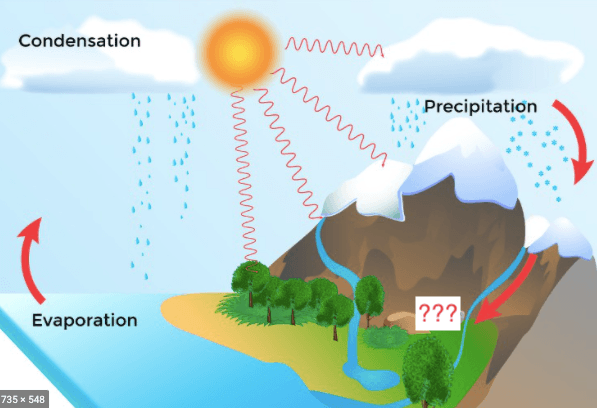
Runoff
Mrs. Tontillo got home from work and wanted to make some dinner. In order to make Mac and Cheese, she had to boil water before she cooked the noodles. Which of the following temperatures will she observe steam evaporating from the water?
A. 110 ℉
B. 150 ℉
C. 32 ℉
D. 216 ℉
D. 216 ℉
Where does runoff take place?
A. From D to A
B. From B to C
C. From C to D
D. From A to B
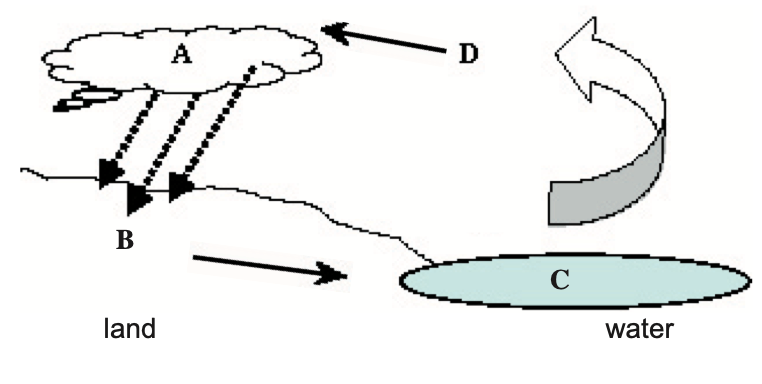
B. From B to C
What is precipitation?
Water that falls from clouds to Earth's surface in the form of rain, hail, sleet or snow
The image below represents which part of the water cycle? 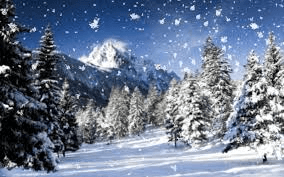
Precipitation
During science class, Mrs. Slodysko says you need to plan an investigation at home to show matter change from a solid to a liquid. Which of the following experiments would show this?
A. Put a cup of water in a bucket of ice.
B. Put a cup of water on the stove to boil.
C. Put a cup of ice in a sunny a spot.
D. Put a cup of ice in the snow.
C. Put a cup of ice in a sunny a spot.
On Christmas morning in 1985, there was a snow storm. After the water droplets fell to the ground as snow, what will happen next?
The water droplet will eventually evaporate because that’s the next step in the water cycle.
What is condensation?
The change of state from a gas (water vapor) to a liquid (water droplets) which takes place in clouds
The image below best represents which part of the water cycle? 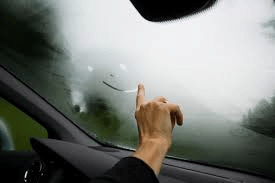
Condensation
Dr. Boyers and Dr. Treadwell are planning an investigation to observe the energy in water when they put a cup of water in the freezer. Who's statement is correct about the investigation?
A. Dr. Treadwell said, "Energy increased from a liquid to a solid when I placed a cup of water in the freezer."
B. Dr. Boyers said, "Energy decreased from a liquid to a solid when I placed a cup of water in the freezer."
C. Both are incorrect. Energy always stays the same no matter what the state of matter is.
Mrs. Slodysko and Ms. Coleman both took their waters out to recess on a warm day. Mrs. Slodysko's cup did not have a lid, but Ms. Coleman's cup did. They both set them down on the bench and forgot to bring them back inside.
What will happen to the water in the cups? How is this related to the water cycle?
A. The amount of water in Ms. Coleman's cup will decrease. The amount of water in Mrs. Slodysko's cup will increase. In the water cycle, water condenses to fill up lakes and rivers.
B. The amount of water in both cups will remain the same. In the water cycle, water evaporates into the air but condenses to form rain and falls back to the earth.
C. The amount of water in Ms. Coleman's cup will remain the same. The amount of water in Mrs. Slodysko's cup will decrease. The water in Mrs. Slodysko's cup may be completely gone. In the water cycle, water evaporates into the air.
D. The amount of water in Ms. Coleman's cup will remain the same. The amount of water in Mrs. Slodysko's cup will increase. The water in Mrs. Slodysko's cup may be completely full. In the water cycle, water evaporates into the air.
C. The amount of water in Ms. Coleman's cup will remain the same. The amount of water in Mrs. Slodysko's cup will decrease. The water in Mrs. Slodysko's cup may be completely gone. In the water cycle, water evaporates into the air.
What is evaporation?
The change of state from a liquid (water) to a gas (vapor) caused by the sun's heat energy
The image below best represents which part of the water cycle? 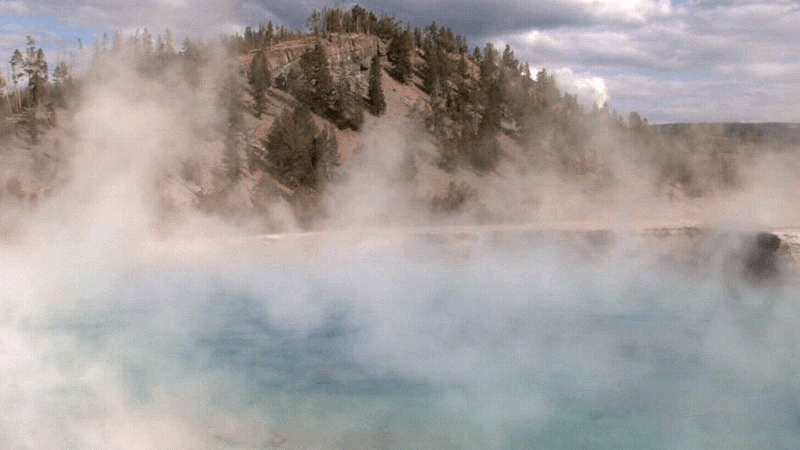
Evaporation
Which would be the best way to label the flow of energy in water as it changes state?
A. The black arrows should be labeled with the phrase “heat removed” and the white arrows should be labeled with the phrase “heat added.”
B. The black arrows should be labeled with the phrase “condensation” and the white arrows should be labeled with the phrase “evaporation.”
C. The black arrows should be labeled with the phrase “freezing” and the white arrows should be labeled with the phrase “melting.”
D. The black arrows should be labeled with the phrase “heat added” & the white arrows should be labeled with the phrase “heat removed.”
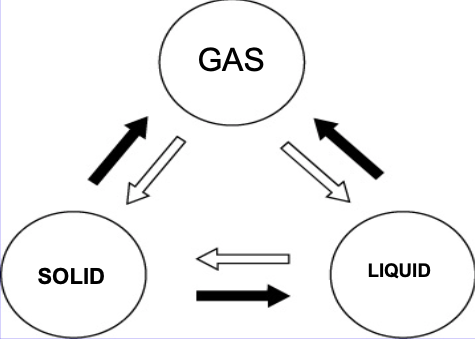
D. The black arrows should be labeled with the phrase “heat added” & the white arrows should be labeled with the phrase “heat removed.”
Ms. Himes is creating a visual to show the water cycle. Which of the following labels would Ms. Himes need to use to correctly complete the model?
A. Label A shows precipitation because the water is running off from the stream to the water.
B. Label B should condensation because water moves from a river to a larger body of water.
C. Label A shows precipitation because the water is falling from the heavy clouds.
D. Label B should condensation because water is formed at ground level.
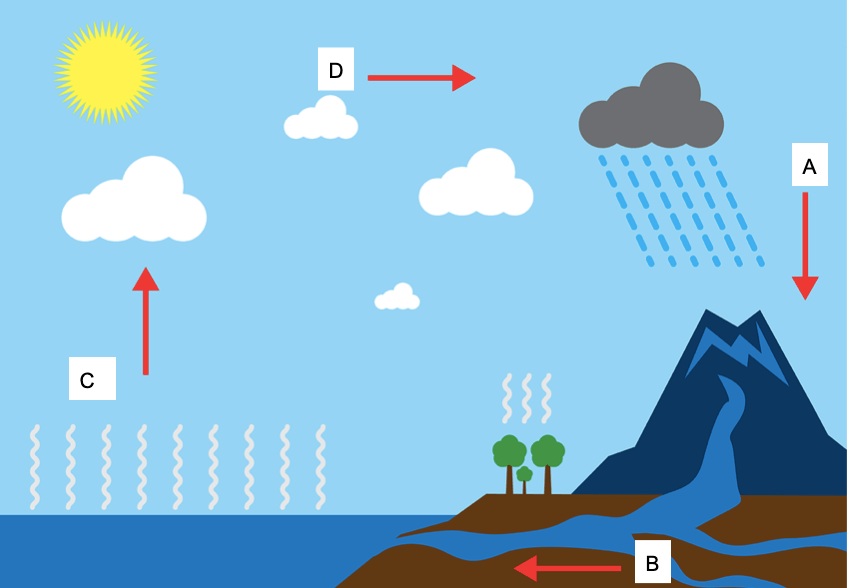
C. Label A shows precipitation because the water is falling from the heavy clouds.
What is runoff?
Precipitation that flows over land to streams, rivers, and lakes
The image below best represents which part of the water cycle? 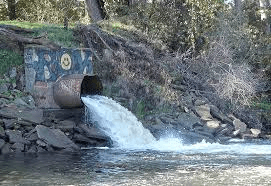
Runoff